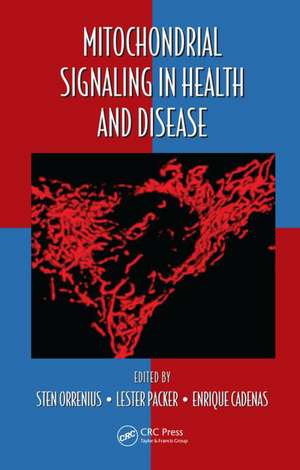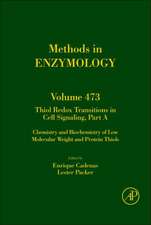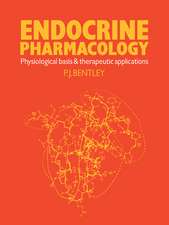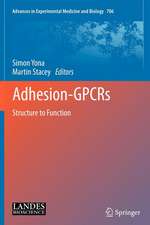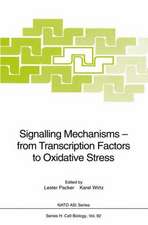Mitochondrial Signaling in Health and Disease: Oxidative Stress and Disease
Editat de Sten Orrenius, Lester Packer, Enrique Cadenasen Limba Engleză Hardback – 20 iun 2012
With contributions from an impressive cadre of internationally recognized scientists, the book discusses coordinated mitochondrial functions that regulate cell function by discrete signaling pathways. Topics discussed include:
- Electron transport and energy production
- Mitochondrial biogenesis and dynamics
- Mitochondrial signaling
- Apoptosis and autophagy
- Pharmacology signaling
- Epigenetic signaling: mitochondrial methylation and acetylation reactions
Din seria Oxidative Stress and Disease
-
 Preț: 356.63 lei
Preț: 356.63 lei -
 Preț: 379.23 lei
Preț: 379.23 lei - 18%
 Preț: 1330.94 lei
Preț: 1330.94 lei - 11%
 Preț: 319.88 lei
Preț: 319.88 lei - 15%
 Preț: 556.99 lei
Preț: 556.99 lei - 25%
 Preț: 410.54 lei
Preț: 410.54 lei - 12%
 Preț: 316.54 lei
Preț: 316.54 lei - 29%
 Preț: 1188.26 lei
Preț: 1188.26 lei -
 Preț: 436.95 lei
Preț: 436.95 lei - 18%
 Preț: 785.60 lei
Preț: 785.60 lei -
 Preț: 447.52 lei
Preț: 447.52 lei -
 Preț: 441.97 lei
Preț: 441.97 lei -
 Preț: 437.13 lei
Preț: 437.13 lei -
 Preț: 356.60 lei
Preț: 356.60 lei - 33%
 Preț: 712.64 lei
Preț: 712.64 lei - 18%
 Preț: 1119.30 lei
Preț: 1119.30 lei - 5%
 Preț: 603.59 lei
Preț: 603.59 lei - 18%
 Preț: 1340.43 lei
Preț: 1340.43 lei - 18%
 Preț: 1349.89 lei
Preț: 1349.89 lei - 18%
 Preț: 2235.06 lei
Preț: 2235.06 lei - 18%
 Preț: 1000.27 lei
Preț: 1000.27 lei - 15%
 Preț: 470.32 lei
Preț: 470.32 lei -
 Preț: 458.67 lei
Preț: 458.67 lei - 10%
 Preț: 317.80 lei
Preț: 317.80 lei - 5%
 Preț: 1038.51 lei
Preț: 1038.51 lei - 5%
 Preț: 1290.50 lei
Preț: 1290.50 lei -
 Preț: 431.18 lei
Preț: 431.18 lei - 18%
 Preț: 1866.69 lei
Preț: 1866.69 lei - 26%
 Preț: 1414.22 lei
Preț: 1414.22 lei - 28%
 Preț: 1525.52 lei
Preț: 1525.52 lei - 29%
 Preț: 1407.70 lei
Preț: 1407.70 lei - 26%
 Preț: 1299.29 lei
Preț: 1299.29 lei - 28%
 Preț: 1576.34 lei
Preț: 1576.34 lei - 26%
 Preț: 1351.70 lei
Preț: 1351.70 lei - 28%
 Preț: 1415.04 lei
Preț: 1415.04 lei - 21%
 Preț: 1497.55 lei
Preț: 1497.55 lei - 25%
 Preț: 1052.93 lei
Preț: 1052.93 lei
Preț: 1343.11 lei
Preț vechi: 1637.94 lei
-18% Nou
Puncte Express: 2015
Preț estimativ în valută:
256.100€ • 269.05$ • 212.65£
256.100€ • 269.05$ • 212.65£
Carte tipărită la comandă
Livrare economică 07-21 aprilie
Preluare comenzi: 021 569.72.76
Specificații
ISBN-13: 9781439880029
ISBN-10: 1439880026
Pagini: 530
Ilustrații: 78 black & white illustrations, 10 colour illustrations, 6 black & white tables
Dimensiuni: 156 x 234 x 29 mm
Greutate: 0.92 kg
Ediția:New.
Editura: CRC Press
Colecția CRC Press
Seria Oxidative Stress and Disease
ISBN-10: 1439880026
Pagini: 530
Ilustrații: 78 black & white illustrations, 10 colour illustrations, 6 black & white tables
Dimensiuni: 156 x 234 x 29 mm
Greutate: 0.92 kg
Ediția:New.
Editura: CRC Press
Colecția CRC Press
Seria Oxidative Stress and Disease
Cuprins
Mitochondria—Reactive Oxygen Species (ROS)—Cell Death. A Healthy Free Radical Pessimism: A Glance from an Oxidative Lipidomics Corner. Mitochondrial Involvement in the Execution of Cell Death. The Role of Protein Kinase C in Mitochondrial Functions in Cardiac Ischemia- Reperfusion Injury. Mitocans, Mitochondria-Targeting Anticancer Drugs: Focus on Mitochondrial Complexes. Therapeutic Potential of Lipoamide and Enhanced Mitochondrial Biogenesis for Treatment of Insulin Resistance. Mitochondria-Targeted Antioxidants.Mitochondria—Metabolism—Nitric Oxide. Lactate Shuttling and the Mitochondrial Lactate Oxidation Complex. Nitric Oxide in the Regulation of Mitochondrial Biogenesis. Effect of Sildenafil on Heart Nitric Oxide Metabolism and Mitochondrial Function. Kinases and Mitochondrial Cycling: The Last Encounter. Acetylation—Deacetylation—Aging. Nuclear Chromatin Factors Defining Mitochondrial Bioenergetics: Implications in Age-Associated Diseases. Mitochondrial Protein Acetylation and Sirtuin-Mediated Deacetylation. Mitochondrial Regulation by Protein Acetylation. Calorie Restriction, Mitochondria, and Longevity in Sacchaomyces cerevisiae. Autophagy and Aging: Keeping Organelles and the Proteome Healthy. Neurodegeneration. Mitochondrial Dynamics and Its Implications in Metabolic Dysregulation and Neurodegeneration. Mitochondrial Abnormalities and Oxidative Stress in Alzheimer’s Disease: Can Mitochondrial Reactive Oxygen Species Signaling Promote Neuronal Survival? The Role of Mitochondria in Parkinson’s Disease and Huntington’s Disease. α-Ketoglutarate Dehydrogenase Complex in Neurodegeneration. R-α-Lipoic Acid as a Potent Agent of Mitochondrial Protection in Alzheimer’s Disease. Mitochondrial Antioxidants in Neuroprotection.
Notă biografică
Sten Orrenius, M.D., Ph.D., holds honorary memberships in the American Society for Pharmacology and Experimental Therapeutics, the American Society for Biochemistry and Molecular Biology, the Society of Toxicology (USA), as well as the Italian and Swedish Societies of Toxicology. He is also a Member of the Royal Swedish Academy of Sciences and a Foreign Associate Member of the Institute of Medicine of the National Academy of Sciences, USA. Dr Orrenius has received honorary doctorates from the Universities of Stockholm, Turin, Konstanz, Buenos Aires, Paris V and Milan. He earned the Merit Award by EUROTOX, the Association of European Toxicologists and Societies of Toxicology, in 1997 and was the recipient of the 2006 Distinguished Lifetime Toxicology Scholar Award by the Society of Toxicology (USA). In 2003, Dr. Orrenius received the first ECDO Career Award for Excellence in Cell Death Research by the European Cell Death Organization.
Enrique Cadenas, M.D., Ph.D., is professor of Pharmacology and Pharmaceutical Sciences at the University of Southern California School of Pharmacy and of Biochemistry and Molecular Biology at the University of Southern California Keck School of Medicine and doctor honoris causa (Medicine) at the University of Linköping, Sweden. His research interests include energy and redox metabolism in brain aging and neurodegenerative diseases, redox signaling, and nitric oxide biology.
Lester Packer, Ph.D., has received numerous distinctions and recently, was awarded the Chevalier de l’Ordre National du Merite (Knight of the French National Order of Merit). He was President of the Society for Free Radical Research International (SFRRI) and founder and honorary President of the Oxygen Club of California (OCC). Dr. Packer has edited more than 100 books and over 800 articles. His work established the foundations for the Antioxidant Network concept that addresses the significance of the cell’s redox status in biology and medicine; the Antioxidant Network is more than a scientific concept, for it embraces a world-wide network of research programs that Lester Packer helped develop by supporting and co-organizing conferences on free radical research in Asia, Europe, and America.
Enrique Cadenas, M.D., Ph.D., is professor of Pharmacology and Pharmaceutical Sciences at the University of Southern California School of Pharmacy and of Biochemistry and Molecular Biology at the University of Southern California Keck School of Medicine and doctor honoris causa (Medicine) at the University of Linköping, Sweden. His research interests include energy and redox metabolism in brain aging and neurodegenerative diseases, redox signaling, and nitric oxide biology.
Lester Packer, Ph.D., has received numerous distinctions and recently, was awarded the Chevalier de l’Ordre National du Merite (Knight of the French National Order of Merit). He was President of the Society for Free Radical Research International (SFRRI) and founder and honorary President of the Oxygen Club of California (OCC). Dr. Packer has edited more than 100 books and over 800 articles. His work established the foundations for the Antioxidant Network concept that addresses the significance of the cell’s redox status in biology and medicine; the Antioxidant Network is more than a scientific concept, for it embraces a world-wide network of research programs that Lester Packer helped develop by supporting and co-organizing conferences on free radical research in Asia, Europe, and America.
Descriere
Mitochondrial dysfunction is a factor in a myriad of pathophysiological conditions, including age-related neurodegenerative disorders, cancer, metabolic syndrome, and cardiovascular disease. This volume examines themes essential for the maintenance of the mitochondrial redox (reduction-oxidation) energy axis. Topics include electron transport and energy production, mitochondrial biogenesis and dynamics, mitochondrial signaling, and apoptosis and autophagy. The book also explores pharmacology signaling and epigenetic signaling, with discussions on mitochondrial methylation and acetylation reactions. The information in this volume is critical to those developing mitochondrion-targeted therapies aimed at assuaging mitochondrial dysfunction or the specific factors contributing to its dysfunction.
